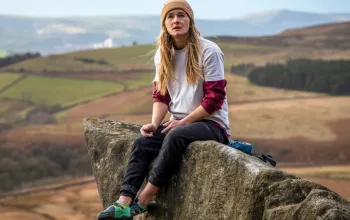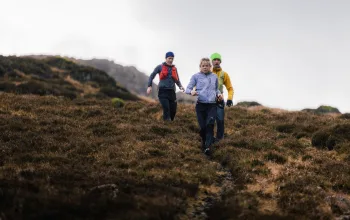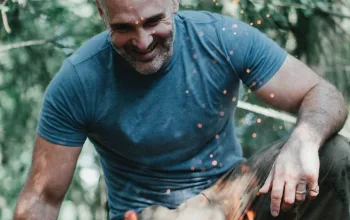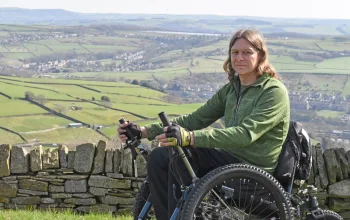With 5.5 million Facebook fans, 1.2 million Twitter fans, Bear Grylls must be one of the most famous faces of adventure in the world. He’s even got a name that sounds like a Boys’ Own Adventure hero – although the story behind how he acquired it is more cute than grizzly.
Christened Edward, it was his older sister who coined the moniker ‘Bear’ – as in ‘Teddy Bear’ for her weeks old baby brother. All the same, the name suits a personality who will be known to most for his daring and extreme survival antics on TV programmes such as Man vs Wild and most recently in the UK, Channel 4’s The Island with Bear Grylls in May.
Grylls’ career in adventure started young, becoming a Cub Scout at eight. Later, at 35, he would be appointed the youngest Chief Scout since its founder Robert Baden-Powell.
First though, there was the robed and privileged private schooling of world-famous Eton. It’s no surprise to hear that he helped found the school’s first mountaineering club.
Growing up on the Isle of Wight, Grylls learned to climb and sail with his politician father, a member of the exclusive Royal Yacht Squadron yacht club based on the island.
After school, and a spell of hiking in the Himalayas, he joined the territorial army, which inevitably led to the challenge of the SAS’s notorious selection.
With a reported pass rate of less than 10 percent, the selection is a six-month test of strength, endurance and resolve that takes place in Wales’s Brecon Beacons and Elan Valley, as well as in the jungle of Brunei. Grylls passed first time. No doubt this is where he acquired his taste for survival skills and eating funny stuff.
The fall that launched
Ironically, it was a fall that launched the next phase of the adventurer’s career. In 1996 he crushed three vertebrae in his back in a freefall parachuting accident in Zambia, when his canopy ripped at 4,900m. With only a partially opened parachute, he landed on his back on his pack, effectively ending his military career but launching his career as a global adventurer.
Just 18 months after the accident Grylls climbed to the summit of Mount Everest at the age of 23, making him one of the youngest ever Britons to do so at the time. The previous year he was the youngest Briton to climb the 6,812m Ama Dablam, a peak which Sir Edmund Hilary himself had called ‘unclimbable’. These ascents proved to be the perfect focus he needed to make the long and difficult journey back from injury.
Grylls’ climbing partner on the Everest ascent was childhood friend, fellow SAS colleague Mick Crosthwaite, who also accompanied him on other challenges – such as their unassisted crossing of the north Atlantic in an open rigid inflatable boat. Enduring gale force winds and icebergs, the team travelled from Nova Scotia to Scotland.
The next ten years saw numerous expeditions and challenges, as he continued to establish his global adventure credentials.
There was the 30-day circumnavigation of the British Iles by jet ski, paramotoring over the Angel Falls in Venezuela, the world record for the highest open-air formal dinner party – taken in full mess kit under a hot air balloon at 7,600m, and paramotoring over the Himalayas, close to Everest’s summit.
All the while, Grylls’ TV career blossomed, with his Channel 4 survival skills series Born Survivor going global. In 2006 his series Man vs Wild showed him climbing cliffs, parachuting out of various aircraft and, of course, eating disgusting things, before lasting seven seasons.
Turning 40 earlier this year – a milestone he celebrated by learning to back flip – his popularity continues to grow, with more TV series such as Running Wild With Bear Grylls due to run, where the adventurer takes celebrities such as Ben Stiller, Channing Tatum and Tom Arnold on two-day trips in the wilderness.
How important was the goal of climbing Everest to your rehabilitation after the parachuting accident? It was so key to my recovery and lit a fire within me while I was going through tough times in rehab. I never took my eyes off that goal and it became my driving force to get strong again.
Was reaching that summit at the age of 23 your proudest achievement? Climbing Everest is undoubtedly one of my proudest achievements. People often have difficulty understanding the attraction of risking one’s life on the freezing, icy faces of a mountain. It rests in the chance of that single, solitary moment on the top. It’s difficult to explain.
Which was harder - Foreign Legion induction or SAS selection? SAS selection was definitely one of my biggest life tests and achievements but it was one that set me up well for so many of the subsequent adventures. It was a long process of attrition where they are looking for the self-motivated. The Legion induction was definitely tough but in the sense that you are treated pretty roughly and trusted with very little, which I found definitely tough mentally.
How influential was joining the Scouts on the direction your life has taken since? The scouts gave me a great sense of family and belonging as well as encouraging in me a thirst for adventure - and of course it was where I began to learn outdoor skills. More importantly though, I see so much evidence nowadays of the confidence that scouting gives kids.
What kind of outdoor adventures do you do with your own children? As a father of three young boys I know what kids hunger for. Great adventures teach them not only great life and outdoor skills, but they also boost their confidence with a sense of knowing that they can look after themselves when the chips are really down.
What are the most important pieces of survival equipment? The three basic items for survival are the snare, the knife and the firesteel: to hunt food, make fire and carve tools for water collection. If I had to choose one it would be the knife. I have used it in every survival situation, in a diverse range of environments such as swamp, jungle, mountain and desert.
If you could teach someone only one practical survival skill, what would it be? When you’re stuck in the wilderness the most important thing you need to find is drinkable water. In this situation, if all else fails, as disgusting as it may seem, you can pee on an item of clothing as this will absorb and store the liquid. This can help you to cool down your head too and at the same time will provide you with a source of essential drinking water in a desperate situation.
What is your ‘favourite’ hostile survival environment: jungle, desert, mountain or open water? Jungle, there are so many survival options in the thick wildlife and it’s an amazing environment to explore!
What is your favourite wild place in Britain? Our own island off the coast of Wales. It is where I love to spend time with my family. We have no mains electricity or water and run everything totally off grid, but we love it!
You’re often filmed eating disgusting things in the wild - how fussy an eater are you at home? It’s true I do eat a lot of nasties out in the wild but at home I’m pretty normal with my food habits! We share the cooking at home – I have a book out next year called ‘Your life: Fuel For It’ that explains the principles of lean, clean, healthy eating. We do have a good few moments of unhealthy cakes along the way as well - but that’s all part of the adventure!
Have you ever turned down a challenge? If so, what?
I’m a Celebrity Get Me Outta Here, Season 1!
Who is the bravest celebrity you have worked with - Jonathan Ross, Miranda Hart, Stephen Fry or Ben Stiller? This is a tricky question: everyone faces their own demons when they are out of their comfort zones, pushing themselves to the max! They are all heroes in my eyes, battling through the wild & putting themselves and their lives on the line beside me. Total respect…
Why did you set up the Survival Academy? So many people kept writing to us suggesting we started one! People want to learn primal life and survival skills as they know that these skills will empowers them. The TV shows that I’ve worked on have really brought out a sense of adventure in people who have watched them and as I love being able to share my survival techniques through the Survival Academy courses.
Have you been surprised by your Survival Academy’s success? The beauty of the courses is that they are ultimately designed for everyone - I think that’s one of the reasons the Survival Academy is seeing such rapid growth. The longing for adventure in people hasn’t changed; it is only that opportunities are harder to find. These courses are for anyone who wants to learn a bit more about themselves and what they are capable of, as well as have a challenging adventure.
What are the core skills people are taught on the courses? People who come on the course learn everything from navigation to river crossings and fire lighting. The Survival Academy teaches people the skills needed to survive in challenging situations. It’s a real variety that equips participants for any situations they may face.
How tough are the courses? They’re going to be tough for everyone but they do vary in length and toughness! The 5 day Survival in the Highlands course is our most extreme in the UK, and one of our most popular. We also offer day courses for kids, and 24-hour courses suitable for the whole family so there is a lot to choose from!
What’s your secret to staying in shape? Sport - I love tennis, and of course I keep fit for my job. I do a lot of paragliding and kayaking. I do try to eat healthily too, but there are days when I relax and eat and drink whatever I like. Generally, I try to avoid meat and dairy.
After learning to back flip for your 40th, what do you plan to learn for your next ‘big’ birthday? Ha! I will of course be in total denial by that stage! But I do need to nail the one-handed hand-stand. So maybe that’s next!
The Bear Grylls Survival Academy runs challenging remote land and sea survival courses around the globe for outdoor enthusiasts of all ages and abilities.





















